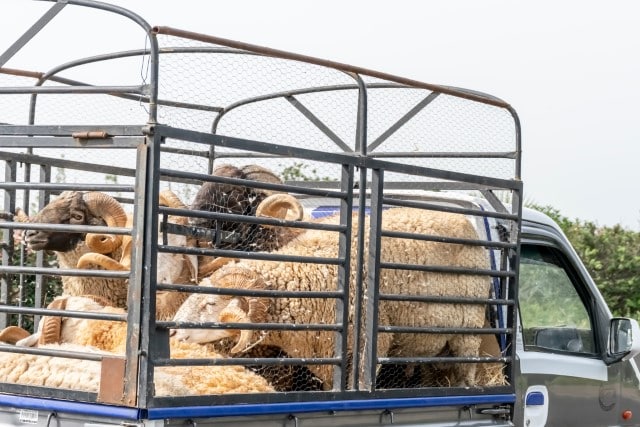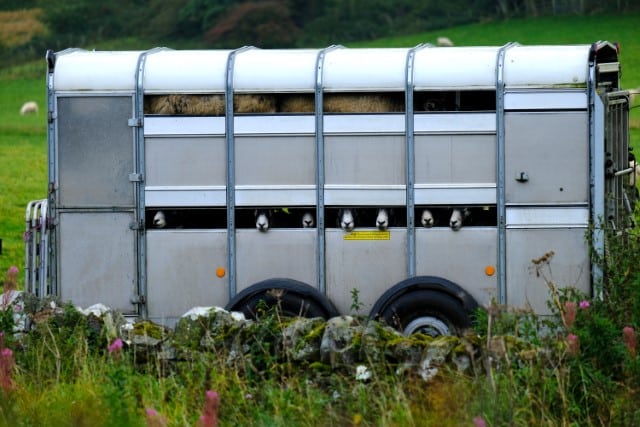Trailers transport livestock to pasture, to fairs and livestock shows, from farm to farm, to auctions, and to the slaughterhouse. Sheep trailers vary in size depending on the type and number of animals they must transport. When choosing a sheep trailer, most farmers opt for a more low-profile trailer. Sheep are shorter than most other types of livestock hauled in trailers. A low-profile trailer creates less drag and is more efficient to pull-tow.
In this article, we’ll discuss the different ways to transport sheep, types of sheep trailers available for sale, sheep trailer alternatives, and how you can select the perfect sheep transportation option for your farm.
Let’s get started!
Do I Need to Buy a Sheep Trailer?
While trailers are usually things you can easily borrow or rent, there’s a variety of reasons why you might want to invest in your own. For example, you may have a large amount of land which necessitates that you move your sheep often. Or you may show your sheep regularly, in which case it will be more convenient to transport them yourself.
Whereas in the past, farmers often used any kind of trailer they had at hand, these days it’s important to use a sturdy aluminum or steel custom stock trailer.

That said – if you only have to transport a small number of sheep then building or buying a truck-bed unit can be a viable (and cost effective) alternative to a sheep trailer. You’ll just want to make sure it is secure and safe for your animals.
This is often something you can build yourself, but you can also purchase pre-fabricated truck toppers like these ones from Alum-Line.
Types of Sheep Trailers
There are two distinct options to choose from when it comes to stock trailers. There’s the standard bumper-pull (sometimes called tag-along) type of trailer, and the larger gooseneck.
- Bumper-pull trailers are usually smaller than gooseneck trailers, but nonetheless come in a range of sizes. These trailers attach to a trailer hitch on the rear of your truck, which is ok for smaller loads.
- Gooseneck trailers can be as large as 36’x7’ so they provide plenty of room for a large amount of livestock. The trailer attaches to your truck above the rear axel, which is a more natural and efficient point of attachment.
I’ll go over these different types of sheep trailers in more detail later in this article. I’ll also provide some of my best tips for what to look for when deciding which type of trailer to purchase for your sheep farm.
Bumper-Pull or Tagalong Trailers for Sheep
The bumper-pull trailer is by far the most common type of hitch. You might also hear it referred to as a drag or tagalong trailer.

The name of this type of trailer is a little misleading, as the trailer does not in fact connect to a vehicle’s bumper, but rather the tongue of the trailer attaches to a ball hitch protruding from the back of the vehicle.
Advantages:
Bumper-pull trailers come with a load of advantages, many of which are due to the small size of the trailers.
Firstly, a bumper-pull trailer is usually far cheaper than a gooseneck. With its smaller size comes less material, and therefore less cost for the manufacturer. It gets even cheaper when you take into account the fact you don’t have to purchase a pickup truck to tow a bumper-pull. You can use a motorhome, an SUV (sport utility vehicle), or CUV (crossover utility vehicle). That lets you either use your existing vehicle or get a vehicle that can do more than just that one task.
Secondly, the weight of a bumper-pull trailer combined with a vehicle rarely exceeds 10,000 lbs. This is good news, as at over 10,000lbs., a trailer is declared commercial and requires a special license. You might be able to avoid needing this special license if you opt for a bumper-pull trailer. However, this can vary from state to state, so it’s recommended that you double-check your local laws.
If you’re a first-time trailer owner, a bumper-pull hitch can be a more advantageous option. Due to its size and popularity, it is much more manageable and less intimidating than a gooseneck. The bumper-pull trailer also has a normal turn radius, meaning that the trailer will turn in conjunction with the vehicle. This too is a big pro for less experienced trailer haulers.
Disadvantages:
Compared to their gooseneck counterparts, bumper-pull trailers do come with some disadvantages.
Firstly, a smaller trailer inevitably entails that there will be less space in your trailer. This can limit the number of sheep you can transport at any one time. If you are travelling far, it might be inconvenient to take several trips back and forth to transport all the sheep. Less space also means less room to partition. It might be difficult, therefore, to separate ewes from rams, for example.
Secondly, you will need to keep an eye on how much weight you are hauling. Check with the manufacturer what the max-weight is before loading up. If there is too much weight on board, then the trailer will lack stability and may start to sway. Needless to say, this can be very dangerous on roads.
Gooseneck Sheep Trailers
Whereas bumper-pull trailers are good for novices, gooseneck trailers are ideal for trailer veterans. This large trailer-type is attached by sliding over a ball hitch on a pickup truck.

These trailers offer additional storage space in the “neck” of the trailer, and are often the ideal size for hay bales and bedding.
Advantages:
The biggest advantage of a gooseneck trailer is its superior stability. This is because the weight is mainly carried over the tongue-connection at the back of the truck instead of the back of the trailer. This prevents too much swaying from occurring. With this enhanced stability comes the opportunity for accommodating greater weight and size in the trailer. This means goosenecks are able to hold far more livestock and have room for partitioning and any additional cargo.
Gooseneck trailers have a much tighter turn radius compared to bumper-pull trailers. This allows you to turn corners more tightly, and maneuver into tighter parking spaces. This tight turn radius can take some practice to get the hang of and any mistakes made on the road can be potentially dangerous.
Disadvantages:
Despite its impressive size and stability, a gooseneck trailer does come with its disadvantages. For one, you won’t be able to haul it without a pickup truck. This also means that the vehicle-trailer combined weight will require a commercial licence.
In addition, as gooseneck trailers are less popular than bumper-pull trailers, most pickup trucks won’t come already equipped with the trailer ball required to attach a gooseneck trailer. You will therefore need to hire a mechanic to come and do this which adds an additional expense to proceedings.
Storing your gooseneck trailer can also be an inconvenience as it takes up a large amount of space.
What’s the Best Type of Sheep Trailer for Your Farm?
Ultimately, choosing between a bumper-pull and gooseneck trailer comes down to exactly what you want to accomplish with your trailer.

If you have a large sheep farm and want to transport a large number of livestock as well as use it to perform other transportation tasks around the farm, then a gooseneck is likely a more appropriate option for you.
If you have a smallholding and only wish to transport a small number of sheep at any one time, as well as hay or other goods occasionally, then a bumper-pull trailer might be your best bet.
Considerations When Buying a Sheep Trailer
Once you’ve decided on whether to opt for a bumper-pull or a gooseneck trailer, it’s time to consider some other factors to make sure you make the optimal purchase for you.

Questions you should answer before buying a sheep trailer for your farm include:
- Will you buy a new or second-hand trailer?
- Do you need a trailer with one or more partitions inside?
- How much storage space for tack will you want?
- In what ways will you use your trailer on your farm (other than transporting sheep)?
- What material do you want your trailer to be made of?
- How much will you spend on your trailer?
Let’s take a look at each of these buying considerations.
New vs Secondhand
Trailers can be very expensive and if you’re on a lower budget, then buying secondhand can be a good way to save some money.
Of course, buying new means the trailer will last longer and will have no wear and tear on initial usage. However, they will invariably come at a higher cost.

Secondhand trailers, however, may need some repair work and equally cannot be expected to last you as long as a brand new one. If you do opt for secondhand, make sure you thoroughly inspect it and are aware of any additional costs you may encounter through repairs. Take it for a test spin too to ensure everything is working as it should.
Partition
It’s important to consider whether you will want a partition in the trailer so as to separate livestock during transit. If you do, look for models which have this partition built-in.

However, you can also buy partitions separately which you can attach as and when are needed. This can be a good option if you intend on using your trailer for multiple purposes.
Storage Space
When you’re deciding on what size trailer to buy, make sure you take into consideration any need for extra storage space for carrying any equipment and calculate this in addition to the quantity of livestock you wish to transport.
Versatility
While the trailer’s principal purpose may be transporting sheep, it can be incredibly useful for performing other tasks around the farm, such as collecting straw or hay, panels or any other farming equipment. You can check with the manufacturer as well as inspecting the trailer yourself to see if it would be equipped for this kind of versatility.
Material
Some homemade trailers are made up of a mixture of wood, steel or aluminum. This can be perfectly adequate, although most manufactured trailers will either be made of steel or aluminum.

Aluminum is lighter weight so can keep the overall weight of your trailer down. Steel, on the other hand, can be stronger and more rigid. A successful combination of the two will be lightweight and robust
Ultimately, you’re looking for durability and sturdiness, so opt for high quality materials, whether steel or aluminum, to ensure you get this.
Price
You can spend as much as $55,000 for a brand new gooseneck trailer, and as little as $5,000 for a 12-foot bumper-pull stock trailer. Consider your budget in alignment with your intentions for the trailer before splashing out unnecessarily, or being too frugal and not getting the best trailer for your needs.
Always look out for a warranty when buying new, as this will indicate whether or not a company truly believes in the durability and quality of a product.
On our farm when we were ready to invest in our own trailer we bought a pre-owned Alum-Line Gooseneck trailer which is as good today as the day we bought it. I can highly recommend their equipment.

